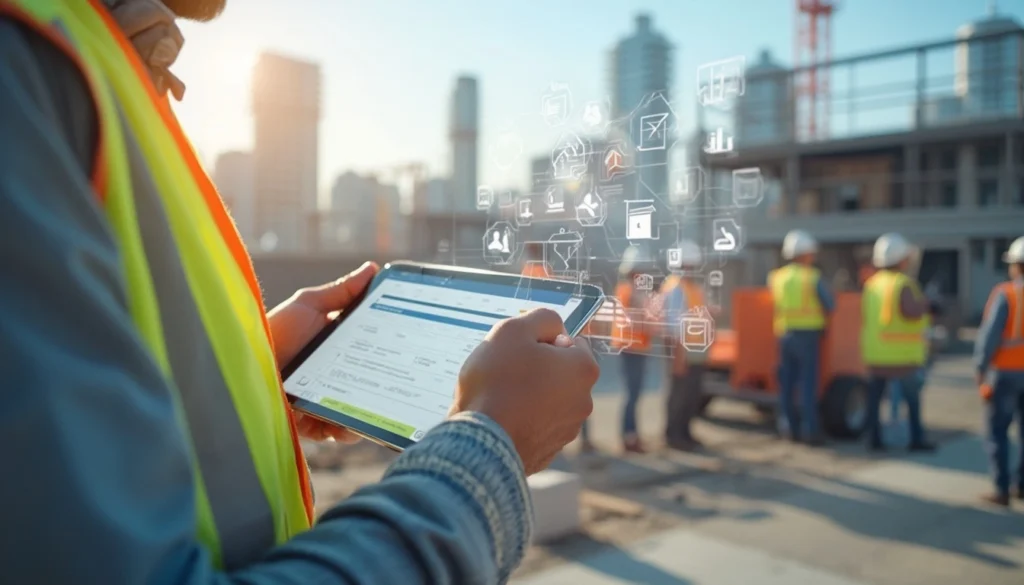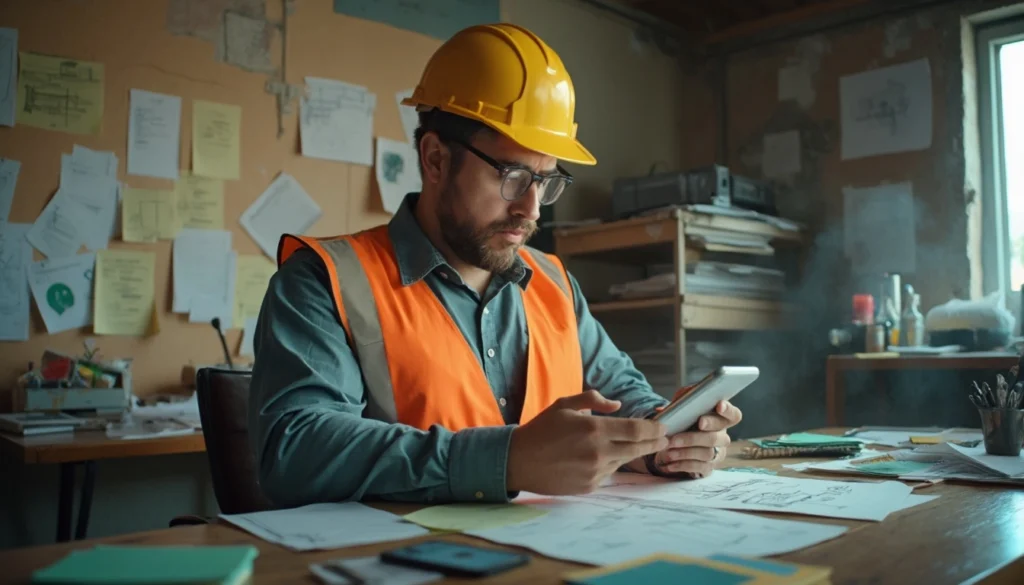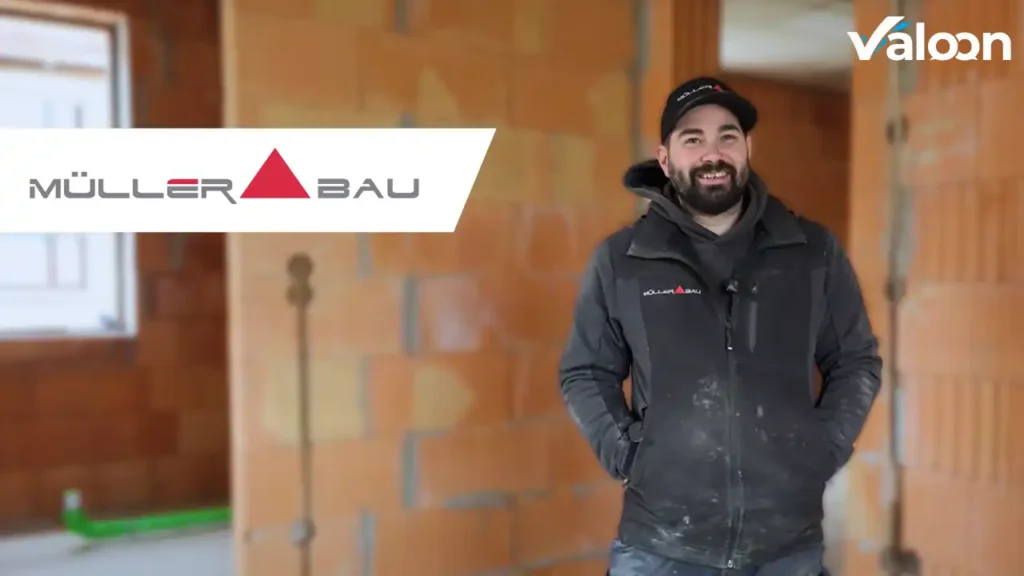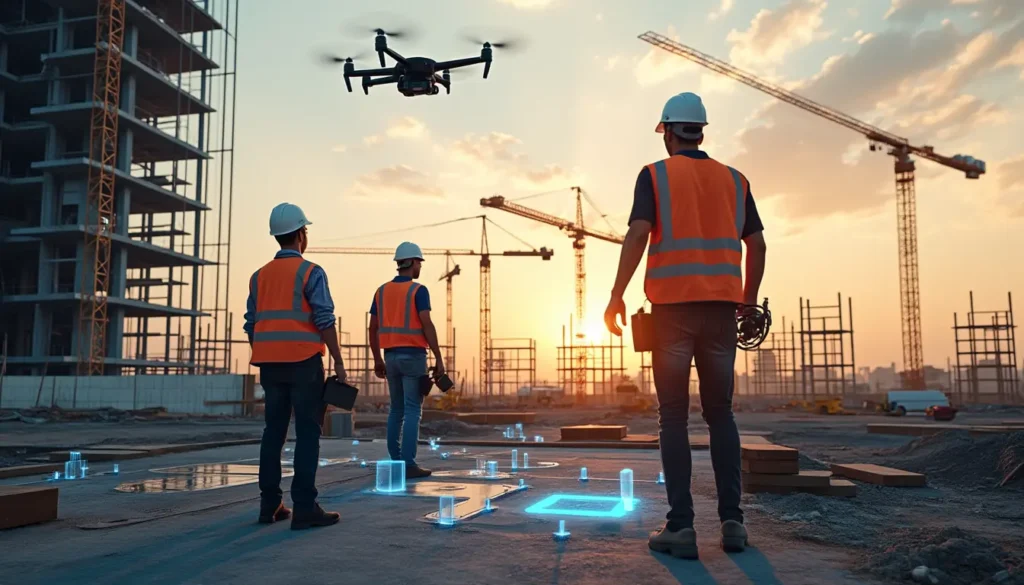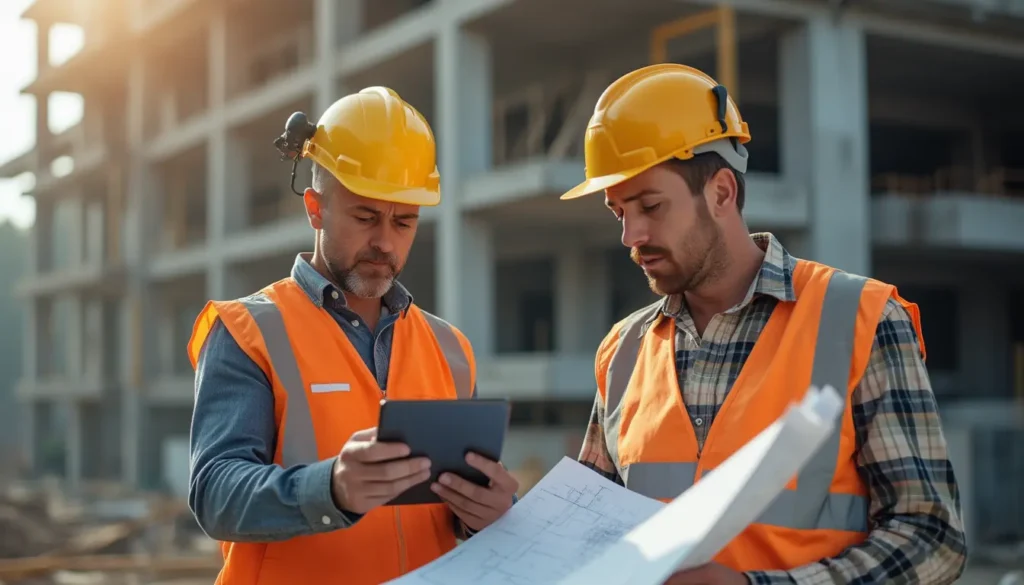Building for Tomorrow: How we shape the future of housing to be human and innovative
When we talk about the housing of the future , we are discussing truly significant changes that go far beyond just erecting buildings. We aim to create living spaces that genuinely meet the complex demands of our dynamically changing society. In light of urbanization, demographic shifts, and increasing environmental awareness, fresh approaches and new technologies are in higher demand than ever. Our conviction is clear: the future of housing, and thus of the housing of the future, needs innovative, sustainable, and flexible solutions. In this article, we will closely examine key aspects such as digitization, sustainability through approaches in the sustainable construction industry, flexible housing models, the tricky question of affordability, and the great potentials of community living. We at Valoon are well aware of these complex tasks and offer you tools to facilitate communication and project management processes in construction, specifically for the housing of the future, efficiently. Let’s explore together how you can prepare your company for the future.
- Der housing of the future creates living spaces that meet the complex demands of a changing society.
- Innovative, sustainable, and flexible solutions are essential in light of urbanization, demographic changes, and environmental awareness.
- Key aspects include digitization, sustainability, flexible housing models, affordability, and community living.
- Valoon supports with tools for efficient communication and project management in future-proof housing construction.
Let’s tackle it: Mastering challenges and trends in the housing of the future
Current challenges in housing construction
The construction industry is famously facing some major obstacles that significantly impact the housing of the future . Exploding energy prices, severe material shortages, and ongoing supply chain issues are exacerbating the already existing housing shortage, particularly in our cities and metropolitan areas. Additionally, there are rising construction costs, which are fueled further by uncertain funding programs and a sometimes very restrictive building legislation, as current analyses show (it’s worth taking a look here: ). The European construction economy is also suffering from relatively high interest rates and material prices as well as a general investment reluctance – experts even believe that the housing market won’t truly recover until 2026 (). All these factors make it clear: we need new strategies for the housing of the future.
Transforming changing housing trends into opportunities
But hey, amidst all these challenges, there are also exciting new housing trends that will shape the housing of the future . The demand for customization and multifunctionality is continually growing; flexible spaces that can easily adapt to home office scenarios or co-working are in higher demand than ever. Likewise, intergenerational housing models are gaining importance – they promote community living among different generations and create wonderful social synergies. Another very important trend is – that is, connected, smart properties that heavily focus on energy efficiency and Ambient Assisted Living (AAL) to enable older or support-needing individuals to live independently. The trends in the construction industry clearly point towards intelligent and adaptable housing concepts for the housing of the future.
Government mandates and the reality of the market
The federal government has set ambitious goals: 400,000 new apartments per year, including 100,000 social housing units. However, this target for the housing of the future is, to be honest, a real mammoth task given the global developments, the challenges mentioned, and the necessity for innovative, often yet-to-be-tested housing models. It’s going to take a true collective effort from all players to achieve significant progress here and to meet the urgent demand in the housing of the future .Without bits & bytes, nothing works: Digital infrastructure as the foundation of future construction
Broadband expansion and 5G as a base for innovation
Let’s be honest, a robust digital infrastructure is no longer a nice extra; it’s a fundamental prerequisite for the future of housing. A comprehensive rollout of broadband networks and the swift implementation of the 5G mobile standard are absolutely crucial for us to fully leverage the potential of modern technologies for the housing of the future . This infrastructure makes the networking of buildings, integration of smart systems, and data-driven services possible – all essential for energy-efficient and comfortable living. Without a solid digital foundation, many innovative concepts for the digital construction future sadly remain just theory.
- A robust digital infrastructure, including broadband expansion and 5G, is the foundational basis for the housing of the future.
- Smart home technologies and logistical automation must be integrated into planning from the very beginning.
- Developing smart quarters with digital solutions for mobility, energy, and local services is crucial.
Advancing the integration of smart living ecosystems
For the housing of the future , we must smart home technologies and logistical automation should simply be included from the outset. This includes intelligent sensors that collect environmental data, connected controls for heating, lighting, and security, as well as systems for automatic ordering or smart shopping using augmented reality. The big question is, of course, how do we establish viable business models and strategic partnerships to effectively utilize the data generated by these integrated systems – even if it comes from unexpected competitors like smart refrigerators. The digital transformation of the construction industry plays an absolutely key role in the housing of the future.
Establishing smart quarters as intelligent urban solutions
We as a housing company can really take the lead and develop smart quarters for the housing of the future by implementing digital solutions for mobility, energy supply, and organizing local businesses and services. This means promoting sharing models for vehicles or resources and ensuring fair, transparent digital structures for the residents. For such neighborhoods, KfW energy-efficient houses are ideal, and KfW construction support is often essential for their realization. These smart neighborhoods must, of course, be energy-efficient and environmentally friendly, promoting local innovation ecosystems to make the housing of the future sustainable.Living as we want: Flexible and community models for new lifestyles
Micro-living and space efficiency: Maximum benefit in minimal space
The trend towards micro-properties? It’s truly challenging us in the housing of the future and calls for advanced architectural designs, which optimally utilize every square meter. The focus is on multifunctional furniture that flexibly adapts to different needs, vertical living solutions to better exploit ceiling height, and innovative storage systems that ensure order. Modular designs are becoming increasingly important for the housing of the future, as they allow apartments to be flexibly adapted to changing life situations, for instance through easily reconfigurable floor plans. Such concepts are of course particularly relevant in densely populated cities where living space is scarce and expensive. The future of the construction industry will be heavily influenced by such space-saving solutions.
Floating homes: Innovative living on the water
And then there are the floating homes, the so-called Floating Homes – a super exciting topic for the housing of the future! However, this requires specific know-how in areas like ship architecture, shipbuilding, and sustainable water management. These structures often need to be autonomous in terms of energy and water. This means employing advanced filtering systems and renewable energy systems like photovoltaics or small wind turbines. An important factor in planning is also to consider the impacts of climate change, especially rising sea levels and increasing extreme weather events, so that these forms of housing remain stable and safe as part of the housing of the future .
Collaborative living: Living together, sharing resources
It’s wonderful to see how shared apartments (WGs) and other forms of collaborative living are becoming really popular again and establishing themselves as a sustainable and socially attractive housing model for the housing of the future . The core of these concepts is to maximize generous shared areas (like kitchens, living rooms, workspaces, gardens) while minimizing purely private retreat spaces. This leads to significant savings in space and energy per person compared to traditional single apartments. There is a huge variety of models tailored to different demographics: senior citizen WGs that enable mutual support in daily life, family-friendly cluster apartments, or multi-generational homes that promote exchange and cohesion. These approaches are a great response to the increasing individualization coupled with the desire for community in the großzügige gemeinsame Bereiche (wie Küchen, Wohnzimmer, Arbeitsbereiche, Gärten) zu maximieren und gleichzeitig die rein privaten Rückzugsräume zu minimieren. Das führt zu deutlichen Einsparungen bei Platz und Energie pro Person im Vergleich zu traditionellen Einzelwohnungen. Es gibt da eine riesige Vielfalt an Modellen, die auf unterschiedliche Bevölkerungsgruppen zugeschnitten sind: Senioren-WGs, die gegenseitige Unterstützung im Alltag ermöglichen, familienfreundliche Cluster-Wohnungen oder Mehrgenerationenhäuser, die den Austausch und Zusammenhalt fördern. Diese Ansätze sind eine super Antwort auf die zunehmende Individualisierung und gleichzeitig den Wunsch nach Gemeinschaft im housing of the future.
Advantages of collaborative living
The advantages of community living are clear and make this model so attractive for the housing of the future:
- Resource efficiency: Shared appliances, spaces, and vehicles reduce individual consumption and protect the environment.
- Social interaction: Shared activities and mutual support counteract loneliness and strengthen the sense of community.
- Cost savings: Shared rent and utility costs often make living more affordable, especially in expensive cities.
Building greener, living better: Sustainability and circular economy at the heart
Circular economy in the construction industry: A paradigm shift
When we talk about the housing of the future When we speak of it, we cannot get past the circular economy – we must commit ourselves clearly. This means that building materials should ideally be 100% recyclable and can be returned to high-quality sustainable material cycles after their useful life. We aim to avoid mountains of waste, conserve our precious resources, and drastically reduce the environmental impact of the construction sector. The development of a , as discussed in studies, could provide transparency here and promote the reuse of building components. This approach requires a real shift in thinking in the planning, material selection, and deconstruction concepts for the housing of the future.
- The circular economy aims to make building materials completely recyclable and minimize waste in the housing of the future .
- The use of green building materials such as wood from sustainable forestry, hemp, or recycled materials is central.
- Bionic architecture uses principles from nature for energy-efficient, resource-saving, and stable construction.
Green building materials: Using nature as a model
The use of plant-based materials, recycled materials, and bio-based composites plays a key role in achieving a more sustainable housing of the future. Wood from sustainable forestry, insulation materials made from hemp or cellulose, clay construction, and recycled materials like recycling concrete are great examples of more environmentally friendly alternatives. When selecting materials, it is important to perform a comprehensive life-cycle analysis that considers the environmental impacts of material extraction, production, transport, use, and disposal. The sustainable construction industry is fortunately increasingly focusing on such innovative and resource-saving materials in the housing of the future.
Bionic architecture: Learning from nature for sustainable design
Have you ever heard of bionics? That is, learning from nature (biomimicry)? This offers us incredibly fascinating approaches for sustainable building design in the housing of the future. Examples include facades that mimic the self-cleaning properties of plant leaves (the famous lotus effect) or building structures inspired by natural construction principles to save material and increase stability. The integration of natural ventilation systems, the use of passive solar heating through intelligent building orientation, and the implementation of rainwater harvesting systems are other elements of bionic architecture that contribute to energy efficiency and resource conservation. Such approaches impressively demonstrate how the construction industry can harmoniously combine technology and nature. Housing for all: How we can ensure affordability and social responsibility in future housing construction housing of the future verbinden kann.Wohnen für alle: Wie wir Bezahlbarkeit und soziale Verantwortung im Zukunftswohnbau sichern
Mastering the challenge of affordability
One of the big challenges we must tackle in the housing of the future is the balancing act between affordability and sustainability. We must succeed in building housing that not only meets ecological requirements but is also financially accessible to broad segments of the population. This requires innovative financing models, an optimized cost structure in the construction process, and a fair distribution of burdens. The study by the BBSR underscores how complex this task is and that we need holistic solutions for the housing of the future , which consider the entire life cycle of a building.
Stakeholder cooperation as the key to success
For the housing of the future to be truly socially responsible and successful, it can only happen with close and trustworthy collaboration among all parties involved. Housing companies, private investors, architects and planners, as well as municipalities must all pull together. Only through integrated planning approaches, transparent communication, and shared responsibility can projects be realized that are economically viable, socially just, and ecologically sustainable. The aller Beteiligten. Wohnungsbaugesellschaften, private Investoren, Architekten und Planer sowie die Kommunen müssen alle an einem Strang ziehen. Nur durch integrierte Planungsansätze, transparente Kommunikation und eine gemeinsame Verantwortung können Projekte realisiert werden, die sowohl wirtschaftlich tragfähig als auch sozial gerecht und ökologisch nachhaltig sind. Die cooperation partners in future housing construction must find new ways of collaboration for the housing of the future .
Applying pragmatism in norms and standards
And one more important point for affordable housing of the future: We need a pragmatic approach to norms and technical standards. High standards are of course important for quality and safety, no question. But an exaggerated or overly rigid interpretation can unnecessarily drive up construction costs and block innovative, cost-effective solutions. It requires a careful weighing of which standards are genuinely necessary and where flexibility or alternative proof methods might be feasible, without compromising essential quality requirements. Focusing on CO2e reduction instead of rigid efficiency standards for individual buildings could open up new pathways for the housing of the future .
Prioritizing long-term affordability over short-term returns
Especially when it comes to social housing and creating permanently affordable living spaces, it must be clear: the long-term affordability for tenants is more important than quick returns for investors. This may require new funding instruments, alternative ownership models, or a stronger role for community-oriented housing companies. The housing of the future must ensure that housing remains a fundamental right and does not become a luxury commodity. The active promotion and financial support of the preservation of affordable housing through extending tenancy agreements is an important lever in this regard.Building smarter, living better: Technology and innovation as engines for efficiency
Smart home technologies for more energy efficiency and comfort
Mit With smart home devices and systems, we can really make strides in the both in terms of energy efficiency and living comfort. By developing and implementing housing of the future advanced algorithms for automated climate control, intelligent lighting management, and on-demand device optimization we can significantly reduce energy consumption. At the same time, user comfort increases through personalized settings and intuitive operation concepts. However, we must always keep the lässt sich der Energieverbrauch signifikant senken. Gleichzeitig steigt der Nutzerkomfort durch personalisierte Einstellungen und intuitive Bedienkonzepte. Bei der Planung und Umsetzung müssen wir aber immer die security and privacy implications of connected devices carefully in mind to ensure users’ trust. The AI in construction offers enormous potential for the housing of the future.
Consistently integrating renewable energy into residential buildings
If we want to truly handle energy sustainably, we must incorporate solar modules, geothermal energy, and solar thermal energy as a matter of course into the housing of the future . The development of advanced energy storage solutions, such as battery storage, and the establishment of intelligent grids (smart grids) are essential in order to maximize self-consumption of renewable energy and stabilize the power grid. Utilizing, wie Batteriespeicher, und der Aufbau intelligenter Netze (Smart Grids) sind dabei unerlässlich, um den Eigenverbrauch erneuerbarer Energien zu maximieren und das Stromnetz zu stabilisieren. Die Nutzung von plus-energy house concepts, where buildings generate more energy than they consume, is an ambitious but super important step towards climate neutrality in the housing of the future. The AI in the construction industry can help us optimally control these systems.
Using hybrid heating systems as a flexible transitional solution
Hybrid heating systems are a really clever transitional solution on the way to 100% renewable heat im housing of the future. These systems intelligently combine renewable energy sources, such as heat pumps or solar thermal energy, with traditional heating systems, for example gas condensing boilers. This allows the cheapest and most environmentally friendly heating source to be used depending on availability and efficiency. The use of green hydrogen or synthetic climate gases in conjunction with fuel cells could be another exciting option in the future, to further reduce the environmental impacts in the housing of the future .
Key technologies at a glance
For the housing of the future there are some particularly exciting technologies:
- Smart metering: Intelligent meters that allow us to capture and optimize energy consumption in detail.
- Building automation: Connected systems that automatically control heating, ventilation, lighting, and shading.
- Predictive maintenance: Sensor-based monitoring of systems to detect maintenance needs early – this significantly impacts the construction industry can harmoniously combine technology and nature. .
Here’s how it’s done: Inspiring examples and case studies for the housing of tomorrow
Construction Culture Workshop Iphofen 2016: Impulses for affordable and high-quality building
Does anyone still remember the ? It was all about exactly this: future-oriented, affordable, and high-quality housing construction, or rather the housing of the future. Central topics at that time included serial and modular construction as a means of increasing efficiency, the innovative use of wood as a sustainable building material, as well as aspects of sustainability and flexibility in floor plan design. Strategies for urban densification and the creation of social housing were also intensely discussed. Such events are super important to identify best practices and push discourse around the housing of the future .
Adaptive reuse projects: Rethinking the existing
Let’s look to Hong Kong: Projects like the ‘Tai Kwun Center for Heritage & Art’ and ‘PMQ’ are simply excellent examples of adaptive reuse of existing building stock. They impressively show how historical or vacant buildings can be transformed into vibrant, multifunctional spaces through creative repurposing concepts. This approach is not only sustainable because it conserves resources and retains gray energy, but also creates unique places with strong identities – an important aspect for the housing of the future, which needs to think beyond mere new constructions. The repurposing of office spaces into housing, as mentioned in the research input, is one concrete example that we could see happening more often with us in the housing of the future .
Tiny houses: Minimalism as a housing trend
And then there are of course the tiny houses – the hype around the little homes (living areas up to 45 square meters) as an alternative to traditional single-family homes simply doesn’t stop and reflects the desire for a reduced, resource-saving lifestyle. The range varies from simply converted construction trailers to architecturally demanding new builds, that demonstrate the housing of the future in a small scale. While tiny houses work great in rural areas or as vacation rentals, their integration into dense urban environments poses a challenge due to the high land requirements per unit – unless one considers vertical stacking concepts. Nevertheless, they provide important impulses for the housing of the future, particularly in terms of space efficiency and sufficiency.
Criteria for successful best practices
Successful projects in the housing of the future often share a few common traits:
- User-centeredness: The needs of the people who will live there later are at the center of the planning.
- Willingness to innovate: Openness to new technologies, materials, and construction methods.
- Holistic approach: Ecological, economic, and social aspects are considered throughout the entire lifecycle.
Let’s tackle it together: Actively shaping the housing construction of the future!
When we look at all the diverse trends and challenges, one thing becomes very clear: the housing of the future requires a genuine rethink and bold, fresh ideas. From digital transformation to sustainable construction methods and flexible housing models to ensuring affordability – the tasks are complex and interconnected. Everyone really needs to pull together: politics, business, academia, and all of us as a society, to set the right course and create livable, future-proof living spaces for all within the framework of the housing of the future . The integration of technologies such as artificial intelligence in the construction industry and the consistent implementation of the digital transformation of the construction industry are absolutely essential. The insights from studies like that of the BBSR on the must now be put into practice.
At Valoon, we are firmly convinced: An optimized communication and really good project management are worth their weight in gold here. This is where our software solutions come in: we transform everyday messenger communication into structured project data and help you break down information silos, improve collaboration between office and construction site, and successfully realize your projects in the housing of the future . By simplifying data collection and sustainably optimizing the flow of information, we ensure that you can focus on what’s essential: the creation of high-quality and future-proof living spaces, the core of housing of the future.
Der housing of the future is a task that we can only tackle together. Just get in touch with us today to find out how Valoon can support you in your projects and how we can revolutionize the construction industry together. Sign up for a demonstration and discover the benefits of our innovative platform for your company. Let’s shape the future of living together – efficiently, sustainably, and tailored to people’s needs, as part of housing of the future. Visit our Contact page, to take the first step.
How can Valoon help my construction company increase efficiency in future housing construction?
Valoon optimizes your construction projects by simplifying the communication between field service and office drastically. By using familiar messengers like WhatsApp for data collection, information is captured faster and more structured , saving time and reducing errors.
What role does digitalization play for my company in future housing construction, and how does Valoon support this?
Digitalization is crucial for competitiveness. Valoon is your bridge to easy digitalization: We automatically transform unstructured communication (e.g., photos, voice messages via WhatsApp) into usable project data , without requiring your employees to learn complex new software.
How does Valoon support the implementation of sustainable construction projects and the use of new materials?
Comprehensive documentation is essential for sustainable projects. With Valoon, you can easily and directly document the use of ecological materials or the installation of renewable energy technologies right from the construction site, improving traceability and reporting.
Can we also optimize communication with Valoon for flexible or modular construction methods?
Yes, especially with flexible and modular construction methods that often require quick adjustments and close coordination, Valoon ensures a smooth flow of information. Changes and progress can be shared and documented in real time , significantly improving coordination.
How does Valoon help increase acceptance of new digital tools among my field staff?
Valoon focuses on usability and the integration of popular messenger services like WhatsApp. Since your employees can use familiar tools, lengthy training sessions are unnecessary, and the acceptance of digital processes increases significantly..
The housing construction of the future demands smart home integration. How can Valoon support this?
The installation and maintenance of smart home technologies require precise documentation. Valoon enables your teams to capture installation steps, test results, and handover protocols directly via messenger and store them centrally, which supports quality assurance.
How can Valoon help counteract the shortage of skilled workers through more efficient processes?
By automating and simplifying administrative tasks like reporting and data entry with Valoon, your skilled workers regain valuable time. They can use this for their core tasks, which increases overall, gewinnen Ihre Fachkräfte wertvolle Zeit zurück. Diese können sie für ihre Kernaufgaben nutzen, was die efficiency..
Does Valoon also support multilingual teams, as are often found in housing construction?
Yes, Valoon offers an automatic translation function in over 50 languages. This is a significant advantage for internationally-oriented teams or when working with subcontractors from different backgrounds, and eliminates language barriers..
